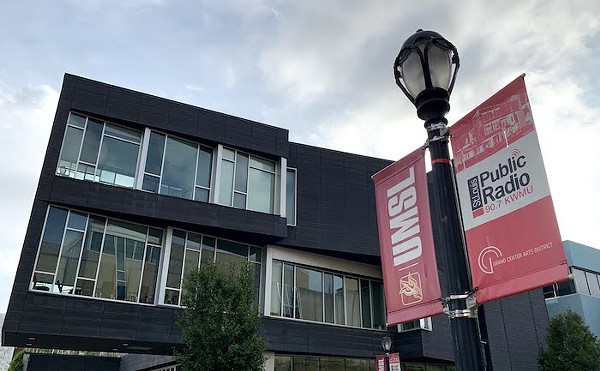Having spent six years in Los Angeles -- mainly toiling alongside his former St. Louis University High School classmate and local-boy-made-good director buddy George Hickenlooper (Hearts of Darkness, Man From Elysian Fields) -- Boll, whose April Is My Religion in 2001 became the first locally produced feature ever to air at the St. Louis International Film Festival (SLIFF), returned to the St. Louis area to care for his quadriplegic father. His assessment of the local filmmaking landscape is unflinching.
"The scene is nowhere near big enough -- or good enough -- to keep anyone with real ambitions," Boll says. "Everyone who gets good leaves. But that could change overnight."
Tucked beneath Boll's arm is a three-minute trailer for a documentary he's co-producing about the infamous Coral Court Motel. Burned out after April, Boll was aimlessly looking for a documentary project when photographer Shellee Graham and the motel idea all but fell into his lap.
"I'd been [to the Coral Court] several times as a patron," says the filmmaker, a sinister grin creeping across his face. "It was exactly what I was looking for."
Co-producer Graham's vast collection of paraphernalia, photographs and contacts tied to the Watson Road motel, which was bulldozed in 1995, have made the typically daunting task of acquiring licensing rights to topical footage a gazillion times easier than it otherwise would have been. "All the legwork was done," Boll says. "Shellee would set up interviews and I'd just show up with the camera."
All set, then. Or not. There was still the issue of cold hard cash, and Boll was at a loss for potential funding sources for a film with no self-evident ties to civic organizations that can often be relied upon if the topic is relevant. Then Graham told him about a buddy of hers, Bruce Marren, who'd secured funding in 2001 for a documentary about Gaslight Square through a little-known grant known as CALOP (Committee for Access and Local Origination Programming), administered by the municipality of University City.
Mere weeks later, after an application process that included a presentation to a selection committee, Boll and Graham had a cool $10,000. Boll expects that the money will cover the cost of the Coral Court project, which he hopes to complete by November.
Regional and statewide arts-commission grants are commonplace nationwide, but CALOP, which seeds the St. Louis film community with some $125,000 annually via grants of $5,000 to $10,000 endowed exclusively for documentary productions, is a rare bird.
The grant program came out of a partnership between U. City and cable provider Continental Cablevision. To satisfy Federal Communications Commission requirements, cable companies typically supply municipalities with public-access channels or production facilities, but University City officials had other things in mind in 1980 when they negotiated their deal for two percent of Continental's local gross revenues.
Initially, the city used the money to purchase video equipment for its public schools. In 1989, the grant program was conceived. (The city's current provider, Charter Communications, now itemizes CALOP on its invoices, at a rate of $1 per subscriber per month.) Grant applications are screened by a committee composed of four U. City residents, a school district representative, a city councilmember and liaisons from the city bureaucracy and Charter. The grant has few stipulations, the main one being that U. City's public-access channel premieres all CALOP documentaries.
"That's pretty unique," Sandra Ruch, executive director of the Los Angeles-based International Documentary Association, says of the CALOP program. "To fund documentaries is always very difficult. [The filmmakers] usually do it through their credit cards or families. That they're funding local artists when the national arts budget is being cut is rather unusual, and rather encouraging."
"I don't know that anybody does anything like it," echoes Scott Rimmell, Charter's liaison to the grant committee.
There's certainly nothing like CALOP in the city of St. Louis, although city-affiliated nonprofit Double Helix Television (DHTV) has committed to airing some CALOP-funded films. In fact, though it's no guarantee, the CALOP imprimatur enhances a film's odds of being accepted for wider broadcast. "Obviously, if somebody at CALOP liked it, that's good," says Patrick Murphy, an award-winning producer at KETC-TV (Channel 9) and a CALOP grant recipient for a 1998 documentary about the Katy Trail.
As the area's PBS affiliate, KETC occupies a key position in the St. Louis documentary-filmmaking food chain. Bill Boll goes as far as to credit Channel 9 with spreading the grant's gospel to the film community. "[U. City] had been doing it for years and years, but nobody knew about it," Boll says. "Then KETC premiered the Gaslight Square documentary, and everyone and their brother is applying for the grant."
Monica McFee, U. City's staff liaison to the CALOP committee, confirms that KETC's September 2002 broadcast of Marren's Gaslight Square: The Forgotten Landmark was indeed a catalyst for heightened interest in the grant program -- or part of one, anyway. The film, McFee points out, had already enjoyed a lengthy run at the Missouri History Museum, and, of course, a screening on U. City's public-access channel.
Since its inception, CALOP has backed 141 documentary projects on a wide array of topics. The number of films varies from year to year, with a high of seventeen in 1990. But CALOP tapped only seven films in 2002 -- a figure topped in the first funding cycle alone in 2003, when eight out of twenty-five films submitted for consideration were funded. McFee expects the September cycle to be even busier, and to push the 2003 flock to a new record high.
Momentum of the sort enjoyed by Gaslight Square is crucial, concurs local filmmaker Chris Grega. "In low-budget filmmaking, if you don't have momentum, you're dead," says Grega, whose first feature, Amphetamine, played to a crowd of 700-plus at the Pageant as part of the St. Louis Filmmaker's Showcase in June. Grega used credit cards to finance the entire $12,000 budget of his film, a fiscally precarious but not-uncommon method.
While the movie has been accepted for the upcoming St. Louis International Film Festival, it would be startling if Amphetamine, a darkly comic local crime story, makes it into wider release. Still, given Grega's relative inexperience -- he'd only done two shorts prior to the feature -- and the fact that the hundreds of people who worked on the film volunteered their time, Amphetamine is a triumph of blood, guts and moxie.
"If you have no money and no resources, you have to build a reputation," Grega maintains. "[Local horror film producer Eric Stanze] told me that for every hundred people who say they want to make a movie, one person finishes. That's totally true."
Doug Whyte, whose CALOP-backed A Slice of Life & Death, a morbidly entertaining documentary about a local funeral director, was recently picked up by a Los Angeles distributor, has momentum. He just received his second CALOP grant, this one for a piece on the residents of the western-themed Silver Spur group home in south St. Louis. But while filmmakers like Bill Boll are content to operate with a guerrilla budget of $10,000 or less, Whyte has pegged the Silver Spur endeavor at $70,000. And with CALOP grants topping out at $10,000, he's having a challenging time of it.
"I'm approaching foundations that support mental illness," recounts Whyte, who works for DHTV by day. "The tricky part is getting funding and not having them have any say in what it's going to be."
For his turn of luck with the LA distribution house Seventh Art, Whyte credits Bobbie Lautenschlager, a 59-year-old Trinity Lutheran secretary who took an interest in filmmaking after a twenty-year stint as a medical missionary in Africa. Every year Lautenschlager makes a pilgrimage to the Sundance Film Festival in Utah and also squeezes in trips to smaller California festivals to circulate reels and trumpet the virtues of St. Louis filmmakers. When she's not road-tripping or answering phones at the Soulard church, Lautenschlager donates her time at Cinema St. Louis, where she's a volunteer curator for SLIFF, an ambitious, third-tier festival now in its twelfth year.
"All it would take is for some major sponsor to come in and help us get first-rate films and actors and directors, to pay for them to come," Lautenschlager contends. "We struggle every year to get money we need for hotel rooms, airfare, parties, dinners, things like that. These other film festivals have a great base of sponsorship."
Whyte points to his short tenure making movies in Milwaukee, where several filmmakers joined forces to form a cooperative, as perhaps a more attainable goal for St. Louis' film community. But Chris Grega, who's considering making a documentary as an encore to Amphetamine, argues that for such a phenomenon to transpire here, local filmmakers will have to find some common ground.
"I'd love to stay in St. Louis and make it an indie-film mecca, like Seattle," Grega says. "But I don't know if it's in the cards. There're a lot of filmmakers here, but there's no unity. If people would unite, there'd be enough drive to have our own studio. But for whatever reason, we're all driving in different directions.
"It's sad that there's nobody else giving any sort of grant at all," he adds, in reference to CALOP. "Everybody gets excited about The Game of Their Lives, but nobody really cares about people doing things day in and day out."





